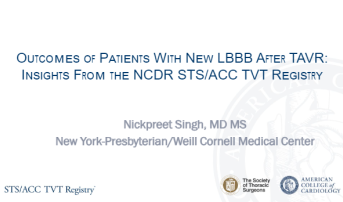Post-TAVI Conduction Abnormalities: EP Study, Registry Data Provide Snapshots
More than two decades into the TAVI era, researchers continue to track predictors and outcomes of these common conditions.

SAN FRANCISCO, CA—Conduction abnormalities like complete heart block (CHB) and left bundle branch block (LBBB) remain common in today’s TAVI patients, with some facing pacemaker implantation or even higher mortality down the road. Two new studies presented here at TCT 2023, more than two decades since the first transcatheter aortic valve replacement, dug into how the therapies meant to address diseased valves also affect the heart’s electrical system, and what can be done about it.
As reported by TCTMD, momentum toward a more-active role for electrophysiologists (EPs) on the heart team is growing as a way to meet this need, encouraged by the awareness that some patients can experience delayed abnormalities after TAVI and that the resulting rhythm disturbances are tied to worse outcomes.
Anywhere from around 5% to 28% of TAVI patients experience atrioventricular (AV) conduction problems, investigator Alfred Buxton, MD (Beth Israel Deaconess Medical Center, Boston, MA), pointed out in a late-breaking clinical science session. “Yet the mechanisms responsible for these abnormalities are not fully clarified,” he said, adding that there’s also uncertainty over the clinical utility of His-bundle recordings during TAVI and the indications for pacing.
The team at Beth Israel Deaconess decided to embark on research both to tease out mechanisms and “to better understand the potential utility of intraprocedural electrophysiologic study” as a means of identifying at-risk patients, Buxton told TCT attendees.
His-bundle recordings can be performed by structural cardiologists and appear useful in predicting risk for AV block. Alfred Buxton
Some progress has already occurred, however, as evidenced by data from the American College of Cardiology/Society of Thoracic Surgeons TVT Registry presented by Nickpreet Singh, MD (NewYork-Presbyterian/Weill Cornell Medical Center, New York, NY). In the same session, he shared results showing a decrease in new LBBB among more than 200,000 TAVI patients over a 7-year period—which he suggested could relate to lower-risk patients, newer-generation valves, and increased operator experience.
Still, when LBBB occurs, it’s linked to higher mortality at 1 year, according to the analysis.
Singh told TCTMD that one surprise from the TVT Registry is that the mortality curves for patients with versus without LBBB “seemed to diverge over the entire 1-year time period. So it’s not like these patients are suddenly developing acute heart block after their hospitalization and all the deaths are related to that.”
Like Buxton, Singh noted in his presentation that estimates for the frequency of conduction abnormalities vary. “More importantly, the clinical implications of development of new left bundle branch block remain similarly unclear, with varying results in prior studies depending on the follow-up length, study size, and surgical risk of the included patients,” said Singh. What data do exist suggest that LBBB is linked to worse outcomes and perhaps less recovery of LVEF.
Their analysis, he added, is meant to provide “greater precision” about this relationship.
Philipp Lauten, MD (Zentralklinik Bad Berka, Germany), commenting on the two studies for TCTMD, agreed with the idea that there should be a larger role for EPs on heart teams, and that structural cardiologists could feasibly perform intraprocedural His-bundle recordings to, among other things, predict risk of AV block. Particularly in patients with preexisting cardiac arrhythmias, such as right bundle branch block (RBBB), EP diagnostics can provide input on “injury of the conduction system, the [ideal] length of monitoring, and temporary pacemaker implantation, as well,” Lauten wrote in an email.
What Role for EP in TAVI?
For the study looking at AV conduction abnormalities more broadly, Buxton and colleagues analyzed data on 399 consecutive patients (mean age 78.4 years; 56% male) treated with TAVI at their center between May 2021 and March 2023. Most (89%) received a Sapien 3 valve (Edwards Lifesciences), while the rest received an Evolut valve (Medtronic).
All underwent an EP study before and after TAVI using a 6-Fr decapolar catheter and ECG leads I, II, III, and V1. The electrode catheters were placed by the structural heart team under the guidance of an EP who monitored the testing throughout the procedure. The team tried to obtain continuous His-bundle recordings when possible. Patients found to have a conduction abnormality stayed at the hospital longer for observation and were discharged with mobile cardiac telemetry for a 2-week period.
At baseline, 11% had atrial fibrillation, 24% a PR interval of > 200 ms, 5% LBBB, 12% RBBB, and 24% left ventricular hypertrophy. One patient had AV block prior to valve placement. Sixty experienced an AV conduction abnormality during valve implantation (two prolonged PR, two Wenckebach, five Mobitz II, and 51 CHB, with most resolving by the end of the procedure).
Twenty patients got a permanent pacemaker (PPM) at the end of TAVI or during that hospital stay, and 20 required a PPM to address CHB or Mobitz II occurring after discharge (at a median of 4 days post-TAVI). One patient died during the TAVI procedure, and there were four late deaths (at a median of 14 months).
With ECG parameters, predictors of heart block during or after the initial hospitalization were baseline RBBB and post-TAVI PR > 300 ms. The latter also predicted heart block after discharge.
“Baseline right bundle branch block was not predictive of late heart block,” said Buxton. “No matter how we look at new left bundle branch blocks or baseline left bundle branch blocks, we could not find any significant relationship to the development of either heart block during the procedure or after discharge.”
With EP parameters, predictors of CHB after discharge were HV interval of at least 80 or 90 ms (post-TAVI), as well as AH interval and Wenckebach cycle length (baseline and post-TAVI). Buxton cautioned that while the associations with late heart block were statistically significant, “the positive predictive value is fairly low, unacceptably low as a measure to decide whether to implant a pacemaker. On the other hand, the negative predictive value is reasonable.”
And finally, “when we look at the anatomic features, it was frustrating that we did not find a huge number of correlates,” Buxton noted. “The depth on the left coronary cusp correlated moderately, and whether predilation had been performed showed fairly weak correlation with risk for late heart block.”
He concluded: “His-bundle recordings can be performed by structural cardiologists and appear useful in predicting risk for AV block.” The contributions of anatomic and procedural variables to delayed heart block were minor, Buxton added.
Especially in this age . . . of patients going home the very next day, it’s critically important to be able to predict those who are at risk for conduction disturbances, which we find to be the main barrier to early discharge. Tamim M. Nazif
Tamim M. Nazif, MD (New York-Presbyterian/Columbia University Irving Medical Center, New York, NY), the discussant following Buxton’s presentation, pointed to the potential clinical relevance of the data.
“I think the robust mechanistic data that you presented today will increase our understanding of this [topic], broaden the foundation of our knowledge, and I hope that it will improve our ability to risk-stratify our patients appropriately,” said Nazif. “Especially in this age . . . of patients going home the very next day, it’s critically important to be able to predict those who are at risk for conduction disturbances, which we find to be the main barrier to early discharge.”
However, he also highlighted the “Herculean task” of performing EP studies in so many patients. “I have some experience doing this and found the logistic barriers, the ability to have the appropriate physicians, equipment, and so on, to be quite a lot,” Nazif commented.
Buxton agreed it was challenging at first, but said that after the first 50 or so cases, doing the His-bundle recordings only added 3 minutes to the TAVI procedure. “I’m not recommending that this should be done universally. But with people having markers that have been noted in the literature that may predict an increased risk for AV conduction abnormalities, especially after the procedure, I think it could be helpful,” said Buxton.
Roxana Mehran, MD (Icahn School of Medicine at Mount Sinai, New York, NY), who moderated a TCT press conference, also said she’s impressed by what it took to do this study. “It really is an unbelievable feat to get something like this done: doing EP studies in these consecutive TAVR patients,” she said, though she cautioned that the results apply to Sapien and can’t be generalized to other valve types.
In the future, perhaps artificial intelligence can be used to tease out predictors of conduction abnormalities in the data, suggested Mehran.
But even now, EP studies are informative, Lauten told TCTMD. “Early intracardiac conduction studies after transcatheter aortic valve replacement allow early risk stratification of patients with new‐onset left bundle‐branch block, thereby obviating the need for unnecessary prolonged temporary pacemaker placement and prolonged monitoring. Pacemaker implantation after TAVR is a predictor for increased mortality so we need in our centers dedicated standard operating procedures to avoid this step.” In the past, pacemakers tended to be implanted very quickly, he noted, but “dedicated EP protocols, which are easy to use, are a very valuable tool and a key step for an even safer decision.”
LBBB Remains Risky
Singh and colleagues, for the analysis of LBBB, turned to the TVT Registry to identify 202,533 patients who underwent TAVI for native aortic stenosis across 806 US sites between January 2016 and September 2022.
A total of 32,933 individuals (16.3%) developed new LBBB, though rates dropped over time: from 19.87% among patients treated in 2016 to 14.35% among those treated in 2022.
By 1 year, the mortality rates were 9.2% and 7.6% in patients with versus without new LBBB (adjusted HR 1.22; 95% CI 1.15-1.28). Those with new LBBB were more likely to be admitted to the hospital for any cause (28.6% vs 23.5%; adjusted HR 1.26; 95% CI 1.22-1.30) and were more likely to receive a pacemaker (7.1% vs 2.1%; adjusted HR 3.62; 95% CI 3.38-3.88). The LBBB group had significantly less improvement in LVEF and quality of life, though Singh said the differences were small, and they had a longer hospital stay for their initial TAVI.
Subgroup analyses showed no interaction between LBBB and 1-year mortality based on age, sex, prior CAD, atrial fibrillation, bicuspid valve, or LVEF.
One cannot take away the confounders that are unmeasured here that could contribute to the mortality of the patients that did develop left bundle branch block. Roxana Mehran
Overall, “these findings do emphasize the importance of utilizing known procedural strategies that minimize the development of LBBB, such as optimizing the depth of implantation, measuring membranous septum length prior to implantation to assist with this, and optimizing valve sizing,” Singh concluded, calling for continued innovation in techniques and valve technologies, research on the best way to monitor patients with new LBBB, and exploration of treatments like resynchronization/left bundle branch pacing.
Mehran, in the media briefing, stressed that this analysis was observational. “I know you did adjustments, but . . . one cannot take away the confounders that are unmeasured here that could contribute to the mortality of the patients that did develop left bundle branch block,” she said, noting that baseline risk could have been influential.
“100%,” agreed Singh. “I think that’s a very important point. Anytime you have a retrospective analysis such as this, there are going to be unmeasured confounders that you can’t adjust for.” The good news, he added, is that the TVT Registry captures many clinical covariates that can inform this math.
Noting that the mortality difference was “huge,” Mehran said, “I still caution people not to be thinking [that someone who develops LBBB] is going to die 20-30% more than one who doesn’t.”
Caitlin E. Cox is News Editor of TCTMD and Associate Director, Editorial Content at the Cardiovascular Research Foundation. She produces the…
Read Full BioSources
Buxton AE. Atrioventricular conduction system changes during transcatheter aortic valve replacement (TAVR): anatomic and electrophysiologic predictors of heart block in prospective 400 patient EPS/TAVR study. Presented at: TCT 2023. October 26, 2023. San Francisco, CA.
Singh N. Outcomes of patients with new LBBB after TAVR: insights from the NCDR STS/ACC TVT Registry. Presented at: TCT 2023. October 26, 2023. San Francisco, CA.
Disclosures
- Buxton, Singh, and Lauten report no relevant conflicts of interest.






Comments